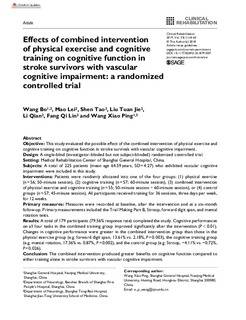| dc.contributor.author | Bo, Wang | |
| dc.contributor.author | Lei, Mao | |
| dc.contributor.author | Tao, Shen | |
| dc.contributor.author | Jie, Liu Tuan | |
| dc.contributor.author | Qian, Li | |
| dc.contributor.author | Lin, Fang Qi | |
| dc.contributor.author | Ping, Wang Xiao | |
| dc.date.accessioned | 2019-06-25T16:59:24Z | |
| dc.date.available | 2019-06-25T16:59:24Z | |
| dc.date.issued | 2019 | |
| dc.identifier.citation | Bo, W., Lei, M., Tao, S., Jie, L. T., Qian, L., Lin, F. Q., & Ping, W. X. (2019). Effects of combined intervention of physical exercise and cognitive training on cognitive function in stroke survivors with vascular cognitive impairment: a randomized controlled trial. Clinical Rehabilitation, 33(1), 54–63. | nb_NO |
| dc.identifier.uri | http://hdl.handle.net/11250/2602186 | |
| dc.description.abstract | Objective:
This study evaluated the possible effect of the combined intervention of physical exercise and cognitive training on cognitive function in stroke survivals with vascular cognitive impairment.
Design:
A single-blind (investigator-blinded but not subject-blinded) randomized controlled trial.
Setting:
Medical Rehabilitation Center of Shanghai General Hospital, China.
Subjects:
A total of 225 patients (mean age 64.59 years, SD = 4.27) who exhibited vascular cognitive impairment were included in this study.
Interventions:
Patients were randomly allocated into one of the four groups: (1) physical exercise (n = 56; 50-minute session), (2) cognitive training (n = 57; 60-minute session), (3) combined intervention of physical exercise and cognitive training (n = 55; 50-minute session + 60-minute session), or (4) control groups (n = 57; 45-minute session). All participants received training for 36 sessions, three days per week, for 12 weeks.
Primary measures:
Measures were recorded at baseline, after the intervention and at a six-month follow-up. Primary measurements included the Trail Making Part B, Stroop, forward digit span, and mental rotation tests.
Results:
A total of 179 participants (79.56% response rate) completed the study. Cognitive performances on all four tasks in the combined training group improved significantly after the intervention (P < 0.01). Changes in cognitive performance were greater in the combined intervention group than those in the physical exercise group (e.g. forward digit span, 13.61% vs. 2.18%, P = 0.003), the cognitive training group (e.g. mental rotation, 17.36% vs. 0.87%, P = 0.002), and the control group (e.g. Stroop, −4.11% vs. −0.72%, P = 0.026).
Conclusion:
The combined intervention produced greater benefits on cognitive function compared to either training alone in stroke survivors with vascular cognitive impairment. | nb_NO |
| dc.publisher | Clinical Rehabilitation | nb_NO |
| dc.subject | physical exercise | nb_NO |
| dc.subject | cognitive training | nb_NO |
| dc.subject | combined intervention | nb_NO |
| dc.subject | stroke | nb_NO |
| dc.subject | vascular cognitive impairment | nb_NO |
| dc.title | Effects of combined intervention of physical exercise and cognitive training on cognitive function in stroke survivors with vascular cognitive impairment: a randomized controlled trial | nb_NO |
| dc.type | Journal article | nb_NO |
| dc.source.pagenumber | 54-63 | nb_NO |
| dc.source.volume | 33 | nb_NO |
| dc.source.journal | Clinical Rehabilitation | nb_NO |
| dc.source.issue | 1 | nb_NO |
| dc.identifier.doi | https://doi.org/10.1177%2F0269215518791007 | |
| dc.description.localcode | måsjekkes | |
